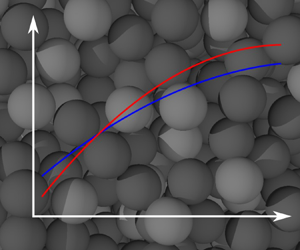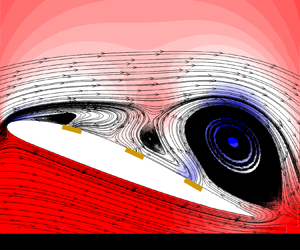doi:10.1017/jfm.2024.1073 Balasubramanian et al. Bursting bubble in an elastoviscoplastic medium
JFM Papers
Temporal evolution of the turbulence interface of a turbulent plane jet
-
- Published online by Cambridge University Press:
- 13 December 2024, A39
-
- Article
-
- You have access
- HTML
- Export citation
Viscoelastic flow around a confined cylinder: 2-D linear stability analysis leading to asymmetric flow
-
- Published online by Cambridge University Press:
- 13 December 2024, A40
-
- Article
-
- You have access
- Open access
- HTML
- Export citation
Linear stability analysis of turbulent mean flows based on a data-consistent Reynolds-averaged Navier–Stokes model: prediction of three-dimensional stall cells around an airfoil
-
- Published online by Cambridge University Press:
- 16 December 2024, A41
-
- Article
-
- You have access
- Open access
- HTML
- Export citation
Frictional effects on shear-induced diffusion in suspensions of non-Brownian particles
-
- Published online by Cambridge University Press:
- 16 December 2024, A42
-
- Article
-
- You have access
- Open access
- HTML
- Export citation
Vibration-induced morphological evolution of a melting solid under microgravity
-
- Published online by Cambridge University Press:
- 16 December 2024, A43
-
- Article
-
- You have access
- HTML
- Export citation
Direct statistical simulation using generalised cumulant expansions
-
- Published online by Cambridge University Press:
- 06 January 2025, A44
-
- Article
-
- You have access
- Open access
- HTML
- Export citation
Dust-free region over horizontal hot surfaces
-
- Published online by Cambridge University Press:
- 06 January 2025, A45
-
- Article
-
- You have access
- Open access
- HTML
- Export citation
Structure and energy transfer in homogeneous turbulence below a free surface
-
- Published online by Cambridge University Press:
- 16 December 2024, A46
-
- Article
-
- You have access
- Open access
- HTML
- Export citation
Dynamics of a thin film of fluid spreading over a lubricated substrate
-
- Published online by Cambridge University Press:
- 16 December 2024, A47
-
- Article
-
- You have access
- Open access
- HTML
- Export citation
Dynamics-preserving compression for modal flow analysis
-
- Published online by Cambridge University Press:
- 06 January 2025, A48
-
- Article
-
- You have access
- Open access
- HTML
- Export citation
A real-time digital twin of azimuthal thermoacoustic instabilities
-
- Published online by Cambridge University Press:
- 19 December 2024, A49
-
- Article
-
- You have access
- Open access
- HTML
- Export citation
Measurements and modelling of induced flow in collective vertical migration
-
- Published online by Cambridge University Press:
- 19 December 2024, A50
-
- Article
-
- You have access
- HTML
- Export citation
Impulse-driven release of gas-encapsulated drops
-
- Published online by Cambridge University Press:
- 19 December 2024, A51
-
- Article
-
- You have access
- Open access
- HTML
- Export citation
The role of fluid–structure coupling in the generation of an attractive squeeze-film force
-
- Published online by Cambridge University Press:
- 19 December 2024, A52
-
- Article
-
- You have access
- Open access
- HTML
- Export citation
Transformer-based in-context policy learning for efficient active flow control across various airfoils
-
- Published online by Cambridge University Press:
- 19 December 2024, A53
-
- Article
-
- You have access
- HTML
- Export citation
Wave packets in laminar supersonic flow over an axisymmetric compression corner
-
- Published online by Cambridge University Press:
- 19 December 2024, A54
-
- Article
-
- You have access
- HTML
- Export citation
Internally heated convection with rotation: bounds on heat transport
-
- Published online by Cambridge University Press:
- 19 December 2024, A55
-
- Article
-
- You have access
- Open access
- HTML
- Export citation
Bounding heat transport in supergravitational turbulent thermal convection
-
- Published online by Cambridge University Press:
- 19 December 2024, A56
-
- Article
-
- You have access
- HTML
- Export citation
Stability of Taylor–Couette flow with oscillatory radial throughflow
-
- Published online by Cambridge University Press:
- 19 December 2024, A57
-
- Article
-
- You have access
- HTML
- Export citation
Capillary lubrication of a spherical particle near a fluid interface
-
- Published online by Cambridge University Press:
- 19 December 2024, A58
-
- Article
-
- You have access
- Open access
- HTML
- Export citation







































































